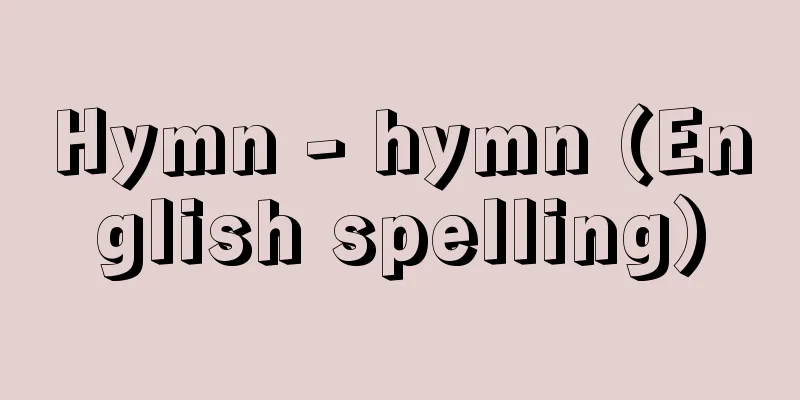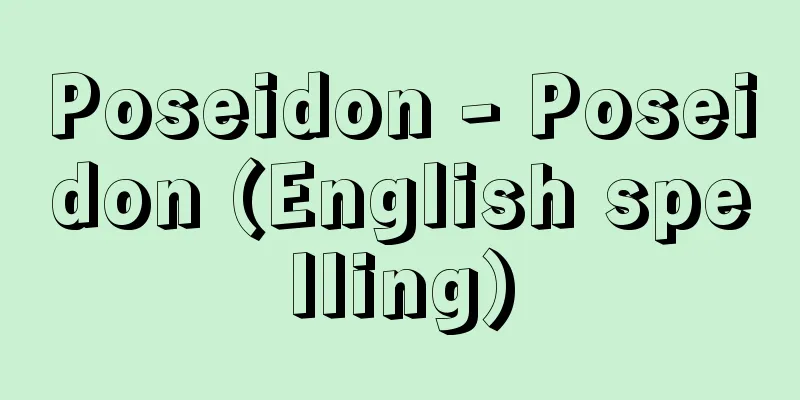Hymn - hymn (English spelling)

|
Songs that praise the Christian God, saints, events, etc. They are synonymous with hymns used in the Catholic Church, but generally refer to religious songs in Protestant churches. Their origins can already be found in the psalms and lyric songs called canticles in the Old Testament (for example, the Song of Moses, Exodus 15:1-18). [Jiro Isobe] Early Christian to Middle AgesAlthough much remains unclear about the nature of hymns in the early Christian period, Paul's letters (Ephesians 5:19, Colossians 3:16) contain references to "psalms," "hymns of praise," and "spiritual songs," which are thought to have been well-known types of songs to the saints of the time. Among these, "hymns of praise" (Greek: hymnos) are considered to be syllabic (one syllable is assigned to one note) poetry created by freely paraphrasing the original text of the Bible, rather than a "hymn" in the broad sense. The first place to contribute to the development of Christian hymnos was Syria, which has produced many poets since the 3rd century. Among them, Ephraem (c. 306-373) of Edessa (now Urfa, Turkey) was a leading figure and is said to be the father of Christian hymns. The creation of hymnos and its use in liturgies spread rapidly throughout the Christian world, but in the Byzantine Empire in particular it flourished in the creation of hymns from the 5th to the 11th centuries. Meanwhile, in the Western Church, Latin hymns began to be composed in the 4th century as the power of the Roman bishops grew. Ambrose, Bishop of Milan (died 397), is particularly important as the person who laid the foundations of Latin hymns. Latin hymns were called hymnus, but unlike the Eastern liturgy, where hymnos was used for all hymns, it came to refer to specific hymns sung in the divine office. The singing of hymnus in the Western Church was discouraged for a long time, but as the unification and organization of the liturgy progressed, it was incorporated into it. As Christianity spread throughout Europe, many non-liturgical hymns were created, including the popular religious song lauda, and polyphonic hymns also began to be composed after the 13th century. [Jiro Isobe] Post-ReformationIn this way, the tradition of hymns from the Middle Ages was steadily passed down, but it was the Reformation movement of the 16th century that breathed new passion into the creation of hymns. In accordance with the Reformation's idea that all believers are priests before God, the German Evangelical Church produced many simple congregational hymns (chorales) in their own language after Luther. The origins of the melodies of these chorales include traditional Catholic chants set to beats and Latin translations into German, German religious songs that existed before the Reformation, paraphrases of old German songs, and purely original songs, which shows Luther's belief that music for worship was not limited to a narrow range. In contrast, Calvin of France believed that the Word of God should occupy the primary position in worship, and opposed the use of original hymns, instead using French verse translations of psalms. Attempts to translate psalm verses into one's own language also spread to Britain, and before long many original hymns were being written. Britain is said to have reached a golden age of hymns from the 18th to the 19th century. American hymns were initially strongly influenced by Britain, but around the 19th century they began to show their own unique characteristics, with the birth of "gospel songs" resulting from religious revivals and "social hymns" that focused on social reform. [Jiro Isobe] Hymns in our countryIn the case of Catholic hymns in Japan, they date back to the Christian era in the 16th century, but the "Public Hymnal" was produced in 1933 (Showa 8). In the case of Protestantism, since the Japanese translation of hymns by American missionaries in 1872 (Meiji 5), each denomination has published its own hymnal, but in 1903 (Meiji 36) a common "Hymnal" was created for all denominations. This hymnal was still heavily influenced by British and American hymns, but after revisions in 1931 (Showa 6) and again in 1954 (Showa 29), "Hymnal 21" was completed in 1997 (Heisei 9). Along with the Anglican Church's "Kokin Hymnal," this forms the core of Protestant hymns in Japan. [Jiro Isobe] "The Story of Hymns" by Cecilia M. Rudin, translated by Abe Takeo (1985, Word of Life Press)" ▽ "The Story of Hymns and Sacred Songs" by Otsuka Noyuri (1995, Sogensha)" ▽ "Collection of Hymns and Sacred Songs from the Meiji Period, supervised by Teshirogi Shunichi, 42 volumes in total (1996-98, Ozorasha)" ▽ "Hymns and Great Composers" by Otsuka Noyuri (1998, Sogensha)" ▽ "Hymns, Sacred Songs and Modern Japan" by Teshirogi Shunichi (1999, Ongaku No Tomosha)" ▽ "A Brief Explanation of Hymn 21" (1998), "Hymn 21 (with Cross-Reading Psalms)" reprint (2000), "Hymn 21 Selection Guide" (2001)" ▽ "The Modern Hymn Renaissance by Yasuhiko Yokosaka" (2001, published by the United Church of Christ in Japan Publishing Bureau) [References] | | | | | |Source: Shogakukan Encyclopedia Nipponica About Encyclopedia Nipponica Information | Legend |
|
キリスト教の神や聖人、できごとなどをたたえる歌。カトリック教会で用いられてきた賛歌と同義であるが、一般にプロテスタント教会の宗教歌をさす場合が多い。その源泉は、すでに『旧約聖書』の詩篇(しへん)やカンティクルcanticleとよばれる叙情的な歌(たとえばモーセの歌――「出エジプト記」15章1~18)にもみいだされる。 [磯部二郎] 初期キリスト教時代~中世初期キリスト教時代の聖歌の実態には依然不明な部分が多いが、パウロの書簡(「エペソ書」5章19、「コロサイ書」3章16)には、「詩篇」「賛美の歌」「霊の歌」の記述があり、これらは当時の聖徒によく知られていた歌の種類と考えられている。そのなかの「賛美の歌」(ギリシア語でヒュムノス)は、広義の「聖歌」よりもむしろ、聖書の原文を自由にパラフレーズするなどして創作された、音節的(一つの音節に1音符があてられる)詩歌とみられている。このキリスト教的ヒュムノスの発展に最初に貢献した土地はシリアで、3世紀以来多くの詩人を輩出した。なかでもエデッサ(現トルコのウルファ)のエフラエムEphraem(306ころ―373)は指導的存在で、キリスト教賛美歌の父といわれている。ヒュムノスの創作とそれを用いる典礼は急速にキリスト教世界に浸透していくが、とくにビザンティン帝国では、5世紀から11世紀ごろにかけて賛美歌創作のうえで繁栄をみた。 一方、西方教会においても、ローマ司教権の増大に伴い、4世紀にはラテン語による賛美歌がつくられ始めた。とくにミラノの司教アンブロシウス(397没)は、ラテン語賛美歌の基礎を築いた人物として重要である。ラテン語による賛美歌はイムヌスhymnusとよばれたが、東方典礼においてヒュムノスがあらゆる聖歌に対して用いられたのとは異なり、聖務日課のなかで歌われた特定の聖歌をさすようになった。西方教会におけるイムヌスの歌唱は、長い間警戒されていたものの、典礼の統一・整備が進むにつれ、そこに取り入れられていった。キリスト教がヨーロッパ各地に伝播(でんぱ)していくと、民衆的な宗教歌ラウダlaudaをはじめ非典礼的な賛美歌が多数生まれるとともに、13世紀以後多声の賛美歌も作曲されるようになった。 [磯部二郎] 宗教改革運動以降このように中世以来の賛美歌の伝統は着実に受け継がれていくが、賛美歌創作に新たな情熱が吹き込まれたのは、16世紀の宗教改革運動によってである。神の前に信徒はみな祭司であるとする宗教改革の理念に従い、ルター以後ドイツ福音(ふくいん)教会においては、自国語による平易な会衆賛美歌(コラール)が多数生み出された。このコラールの旋律の起源には、従来のカトリック聖歌に拍子付けし、ラテン語をドイツ語に訳したものや、宗教改革以前から存在したドイツの宗教歌、ドイツの古歌をパラフレーズしたもの、および純粋な創作歌などがあり、礼拝用の音楽を狭い範囲に限定しなかったルターの信念がうかがえる。これに対し、フランスのカルバンは、礼拝において主要な地位を占めるべきは神のことばであるとして、創作歌としての賛美歌の使用に反対し、フランス語韻文訳の詩篇を用いた。 自国語への詩篇韻文訳の試みはイギリスにも波及し、やがて創作賛美歌も数多くつくられるようになった。18世紀から19世紀にかけて、イギリスでは賛美歌の黄金時代を迎えたといわれている。またアメリカの賛美歌は、当初イギリスの影響を強く受けたが、19世紀ごろから独自の性格を示し始め、信仰復興運動による「福音唱歌」や、社会の改造に重点を置いた「社会的賛美歌」が生まれた。 [磯部二郎] わが国における賛美歌日本における賛美歌は、カトリックの場合16世紀のキリシタン時代にさかのぼるが、1933年(昭和8)には『公教聖歌集』が生まれている。プロテスタントでは、1872年(明治5)のアメリカ人宣教師による邦訳の賛美歌以来、各教派がそれぞれ個別に賛美歌集を出していたが、1903年(明治36)には各派共通の『讃美歌』が誕生した。この歌集にはまだ英米賛美歌の影響が強かったが、1931年(昭和6)の改訂、さらに54年(昭和29)の改訂を経て、97年(平成9)に『讃美歌21』ができあがった。これは聖公会の『古今(こきん)聖歌集』とともに、日本のプロテスタント賛美歌の中心をなしている。 [磯部二郎] 『セシリア・M・ルーディン著、安部赳夫訳『賛美歌物語』(1985・いのちのことば社)』▽『大塚野百合著『賛美歌・聖歌ものがたり』(1995・創元社)』▽『手代木俊一監修『明治期讃美歌・聖歌集成』全42巻(1996~98・大空社)』▽『大塚野百合著『賛美歌と大作曲家たち』(1998・創元社)』▽『手代木俊一著『讃美歌・聖歌と日本の近代』(1999・音楽之友社)』▽『日本基督教団讃美歌委員会編『讃美歌21略解』(1998)、『讃美歌21(交読詩編付き)』再版(2000)、『讃美歌21選曲ガイド』(2001)』▽『横坂康彦著『現代の賛美歌ルネサンス』(2001・以上日本基督教団出版局)』 [参照項目] | | | | | |出典 小学館 日本大百科全書(ニッポニカ)日本大百科全書(ニッポニカ)について 情報 | 凡例 |
<<: The School of Saint Victor
>>: Saint-Pierre (English spelling) Charles Irénée Castel, abbé de Saint-Pierre
Recommend
road running
...It is often done by long-distance runners as p...
Damrosch, Walter Johannes
Born January 30, 1862 in Breslau (now Wrocław, Pol...
Guisan, Henri
Born: October 21, 1874, Mezieres Died: April 8, 19...
Tomozuri
〘Noun〙 A way of fishing for sweetfish. A unique Ja...
Sweat gland
It is one of the skin glands in the subcutaneous ...
Strip line - Strip line
A type of radio wave transmission line. It is a li...
The tomb of Emperor Ojin
Also known as Hondagobyoyama Tomb or Kondayama Tom...
Kafka - Franz Kafka
German-language writer born in Prague. He was bor...
Statue - Dazo
Cracks that appear when a crystal face is poked ha...
pace
…(4) Degrees according to the capabilities of hum...
Stream of consciousness
A literary term. It refers to an experimental tec...
Tahara Domain
A small Fudai domain that ruled over the villages...
vidian neuralgia
...Treatment is the same as for migraine headache...
Gokinai-shi - Gokinai-shi
A comprehensive geographical guide for the five re...
Federal Trade Commission
A highly independent government agency that monit...









